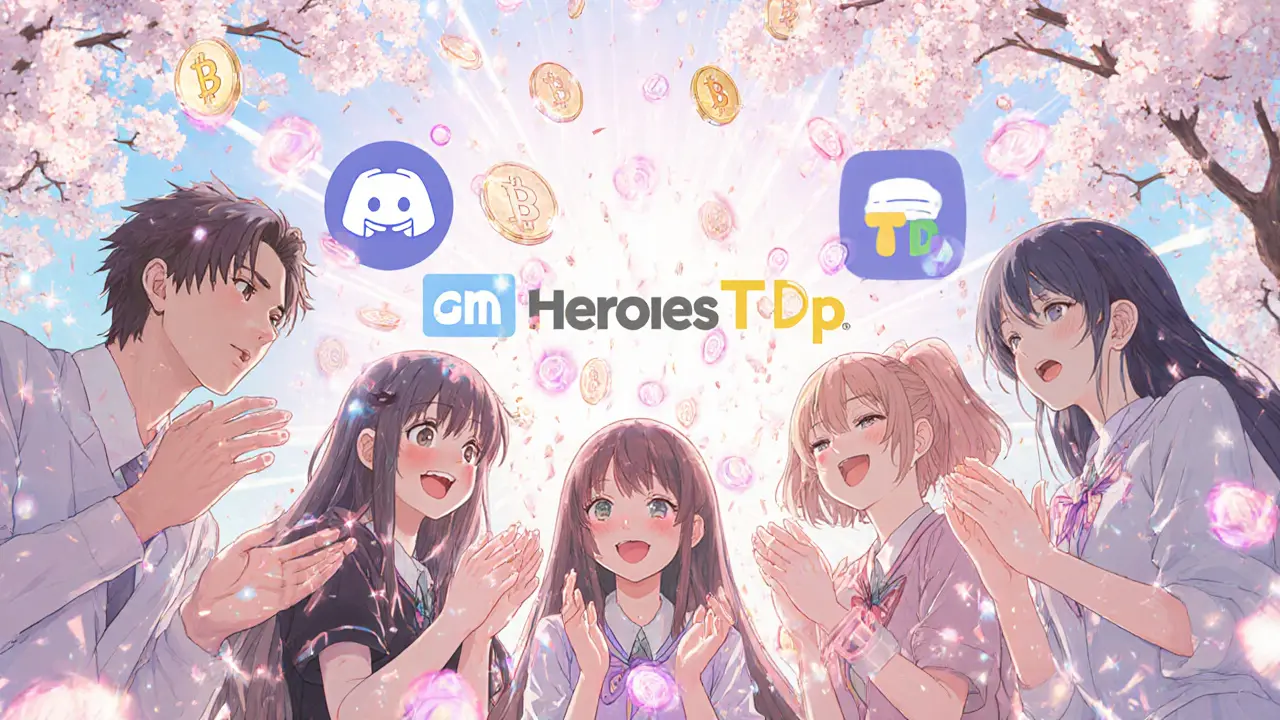HeroesTD (HTD) CoinMarketCap Airdrop Details, Token Info & Claim Guide

HeroesTD Token Value Estimator
HTD Token
Utility token for staking and marketplace fees
CGC Token
In-game currency for hero summoning
Current Market Prices
HTD Price: $0.0059
CGC Price: $0.0002
Prices updated on October 2, 2025
Your Portfolio Summary
Total Value: $0.00
Estimated in USD
Spotting a new airdrop on CoinMarketCap can feel like finding a secret level in a tower‑defense game - you know there’s a reward, but the steps to unlock it are often hidden. The HeroesTD airdrop tied to a recent CoinMarketCap event promises free HTD tokens for active community members, yet the details are scattered across forums, airdrop trackers, and the project's own channels. This guide pulls everything together: what HeroesTD actually is, how its dual‑token economy works, the exact requirements (or the lack thereof) for the CoinMarketCap event, and a practical checklist for claiming any future drops.
Quick Summary
- HeroesTD runs on BNB Smart Chain and uses two tokens - HTD (utility) and CGC (in‑game).
- Current HTD price hovers around $0.005-$0.003, with a market cap of ~US$2.7M.
- CoinMarketCap lists an ongoing "HeroesTD Event Airdrop" but no official eligibility rules have been published yet.
- Typical GameFi airdrop criteria include holding HTD or CGC, completing a summon, or joining the Discord/Telegram.
- Follow the step‑by‑step claim checklist below to stay ready for the next distribution.
What Is HeroesTD?
When you first hear about HeroesTD is a blockchain‑based tower‑defense game built on the BNB Smart Chain. The developers market it as “The Ultimate Metaverse Collectible Strategy Tower Defense Game.” Players deploy NFT Heroes on a battlefield, earn tokens for victories, and can summon new Heroes by burning or combining existing ones.
The ecosystem revolves around two native tokens:
- HTD - the main utility token used for staking, marketplace fees, and occasional rewards.
- CGC (Cloudspire Gold Coin) - powers Hero summoning and entry fees for competitive modes.
Both tokens are BEP‑20 contracts, meaning they benefit from low gas costs and fast confirmation times, essential for a game that processes dozens of transactions per minute.
HTD Token Snapshot
As of 2October2025, the HTD token shows the following on major trackers:
| Metric | Value |
|---|---|
| Current Price (USD) | $0.0059 (Coinbase) / $0.0032 (alternative source) |
| Circulating Supply | 455,285,563.5 HTD |
| Market Cap | ~$2,666,046 |
| 24‑h Volume | $1,080 |
| All‑Time High | $5.62 (‑99.90% from peak) |
Liquidity is thin, with most trades occurring on decentralized exchanges (DEXs) like PancakeSwap. The token is not listed on large centralized platforms such as Coinbase, which limits exposure but also reduces the risk of sudden delisting.
CGC Token Overview
The secondary token, CGC, supplies the game’s core mechanics:
| Attribute | Detail |
|---|---|
| Total Supply | 11.82M CGC (fully minted) |
| Circulating Supply | 11.82M CGC (matches total) |
| Primary Use‑Case | Hero summoning, entry fees for Challenge/Tournament modes |
| Withdrawal | Can be moved to external wallets and traded on DEXs |
Summoning works by burning two existing NFT Heroes, receiving a new Hero with a limited "Summon Count" of seven uses. Each use raises the summon cost but also improves the chance of better equipment, creating a built‑in deflationary loop for the NFTs.

CoinMarketCap Event Airdrop - What We Know
CoinMarketCap occasionally partners with projects to run “event airdrops.” These usually require community actions such as following social channels, completing a KYC, or holding a minimum amount of the project’s token. For HeroesTD, the platform lists an "HeroesTD Event Airdrop" under the 2025 airdrop calendar, but the official announcement page is still a placeholder.
Based on patterns from similar GameFi drops, the likely eligibility criteria include:
- Holding at least 100 HTD or 10 CGC in a BEP‑20 compatible wallet.
- Being a member of the official HeroesTD Discord or Telegram for the past 30days.
- Completing at least one Hero summon or winning a match in the Challenge mode.
- Filling out a short form on the CoinMarketCap event page (email + wallet address).
Because no smart contract for the airdrop has been published, the distribution will likely be manual - the team will batch‑send tokens to verified wallets after the qualification window closes.
Step‑by‑Step Checklist to Prepare for the Airdrop
- Secure a BNB Smart Chain wallet. MetaMask, Trust Wallet, or Binance Chain Wallet all work. Make sure you have some BNB for gas.
- Buy a small amount of HTD or CGC on PancakeSwap. Even 0.01BNB worth is enough to meet most holding thresholds.
- Join the official HeroesTD Discord (invitation link) and stay active - post in #airdrop‑updates, react to announcements, and keep your account verified.
- Connect your wallet to the HeroesTD web portal and perform one “Summon” using CGC. Screenshot the transaction hash as proof.
- Visit the CoinMarketCap event page (search "HeroesTD airdrop" on CoinMarketCap). Fill out the registration form with your email and BEP‑20 address.
- Watch the official HeroesTD Twitter for the final eligibility cut‑off date. The team usually announces the snapshot timing a week before distribution.
- After the snapshot, keep your tokens in the same wallet. The team will send the airdrop directly - no need to claim manually unless a claim portal is announced.
Completing these steps puts you in the top‑tier bracket for most community‑driven airdrops. Missing any one can mean being left out, as the process is not automated.
Why the Airdrop Matters - Token Economics Insight
Injecting free HTD into active players serves two purposes:
- Liquidity Boost. With only $1K of daily volume, adding a few thousand tokens can raise trading activity on PancakeSwap, narrowing the bid‑ask spread.
- Retention Engine. Players who receive HTD are more likely to stake it in the game’s treasury, earning a share of transaction fees and keeping the in‑game economy healthy.
However, a sudden token influx can also depress price if holders dump immediately. That’s why the team typically caps the airdrop amount to a modest percentage of the circulating supply - current rumors suggest a 0.05% allocation, roughly 227,000 HTD.
Risks & Practical Tips
Even a well‑intentioned airdrop carries risk:
- Scam Alerts. Fake “HeroesTD Airdrop” sites often ask for private keys. Never share your seed phrase.
- Liquidity Slippage. With thin volume, large sell orders can push the price down rapidly. Consider holding for at least a week before trading.
- Regulatory Uncertainty. Some jurisdictions treat airdropped tokens as taxable income. Keep records of the token amount and the date received.
Best practice: after receiving the airdrop, transfer a portion to a cold wallet, and only swap the rest when the market shows stable buying pressure.
Next Steps - Stay Informed
If you’re serious about HeroesTD, treat the airdrop as just one entry point. Here’s a short roadmap:
- Complete the airdrop checklist above.
- Explore the game’s “Challenge” mode to earn CGC without spending extra tokens.
- Stake HTD in the HeroesTD treasury to receive passive rewards.
- Follow the official blog and Twitter for upcoming updates - the team plans a Q4 2025 expansion that could introduce a new NFT line.
- Consider diversifying into other GameFi projects on BNB Smart Chain to balance risk.
By staying active, you’ll not only qualify for future drops but also become part of the community that helps shape the game’s direction.

Frequently Asked Questions
When is the HeroesTD CoinMarketCap airdrop scheduled?
The exact date has not been published yet. The project usually announces the snapshot window 7‑10 days before distribution on Discord and the CoinMarketCap event page.
Do I need to hold HTD or CGC to receive the airdrop?
While the official criteria are still pending, most similar GameFi drops require a minimum balance of either 100 HTD or 10 CGC in a BEP‑20 wallet at the snapshot time.
How can I verify that I received the airdrop?
Check your BNB Smart Chain address on BscScan. The airdropped HTD will appear as a BEP‑20 token transfer from the HeroesTD airdrop contract (once disclosed).
Is the airdrop taxable?
Tax treatment varies by country. In many jurisdictions, airdropped tokens are considered ordinary income at fair market value on the receipt date. Consult a tax professional for local guidance.
What should I do if I receive a phishing link claiming to be the HeroesTD airdrop?
Never click unknown links or provide private keys. Verify any announcements on the official HeroesTD Discord, Twitter, or the CoinMarketCap event page before taking action.
Jonathan Tsilimos
The HTD token operates under a BEP‑20 standard facilitating low‑latency settlements on the BNB Smart Chain while the dual‑token architecture delineates utility and in‑game currency functions essential for liquidity provisioning and fee arbitration.
jeffrey najar
To maximise airdrop eligibility, ensure your wallet holds at least the baseline HTD threshold, keep a modest BNB reserve for gas, and maintain an active presence on the official Discord channels; this combination generally satisfies the criteria observed in comparable GameFi distributions.
Rochelle Gamauf
The introductory exposition of HeroesTD purports to innovate within the GameFi sector.
The paucity of verifiable on‑chain metrics raises concerns.
The project's whitepaper lacks comprehensive audits.
Moreover, the reliance on speculative community incentives betrays a superficial developmental framework.
The token distribution model appears heavily skewed towards early investors.
Subsequent holders are left with minimal upside potential.
Liquidity provision on PancakeSwap remains thin, exacerbating price volatility.
The absence of a clear roadmap further erodes confidence.
Community engagement is limited to periodic Discord announcements.
Such communication does not substitute for transparent governance.
The dual‑token architecture, while conceptually interesting, is insufficiently delineated.
Utility for HTD beyond staking is currently ambiguous.
In‑game mechanics tied to CGC lack documented economic safeguards.
Potential regulatory scrutiny could arise from ambiguous token classifications.
Consequently, prospective investors should exercise heightened due diligence before participation.
Jerry Cassandro
Additional insight reveals that the PancakeSwap liquidity pool for HTD presently exhibits a spread exceeding fifteen basis points, indicating that large trades may incur notable slippage, a factor prospective participants should duly acknowledge.
Parker DeWitt
Honestly the hype surrounding this airdrop feels manufactured 🚩, yet opportunistic players can still leverage the token’s low market cap to accumulate positions before any potential pump materialises 📈.
Allie Smith
i think the community vibe around HeroesTD is super chill and the airdrop could be a cool boost for new players, just remember to hold onto some HTD and enjoy the game!
Lexie Ludens
It's absurd how the project banks on fleeting hype, ignoring sustainable gameplay mechanics; this shallow approach will inevitably erode user trust and precipitate a rapid devaluation.
Aaron Casey
From a strategic perspective, integrating HTD staking into the treasury amplifies fee recirculation, thereby enhancing token utility and fostering a resilient economic loop for participants.
Leah Whitney
Maintaining consistent Discord engagement alongside periodic summoning activities creates a robust participation profile that aligns well with typical airdrop qualification benchmarks.
Lisa Stark
Beyond mere financial incentives, the airdrop symbolizes a collective gesture that binds community members through shared anticipation and mutual benefit.
Logan Cates
One might suspect that the airdrop timing aligns with broader market manipulations designed to inflate token volume ahead of undisclosed listings.
Shelley Arenson
Sounds like a solid plan 😊
lalit g
While cautious optimism is warranted, observing the project's upcoming roadmap milestones will provide clearer insight into the long‑term viability of the token ecosystem.
Reid Priddy
Given the limited liquidity and the project's nascent stage, allocating significant capital to the airdrop may be disproportionately risky compared to alternative DeFi opportunities.